Hitachi C 7SB2, C 7BD2 User Manual
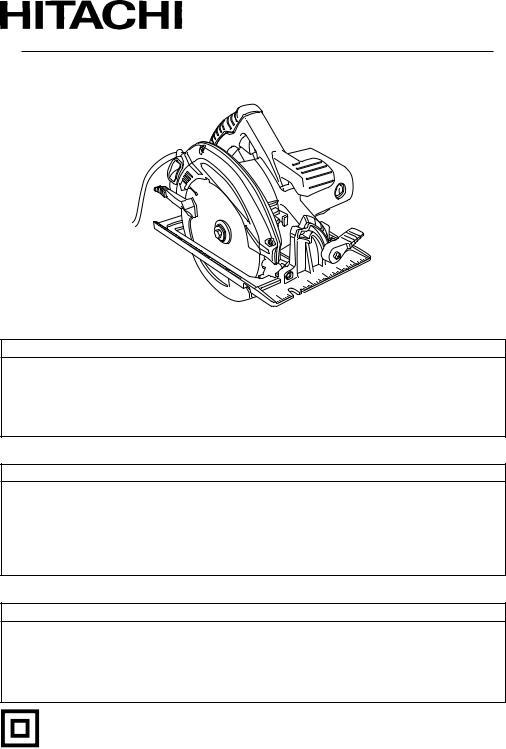
Model |
C 7SB2 • C 7BD2 |
Circular saw |
Modèle |
Scie circulaire |
|
Modelo |
|
Sierra circular |
SAFETY INSTRUCTIONS AND INSTRUCTION MANUAL
 WARNING
WARNING
IMPROPER OR UNSAFE use of this power tool can result in death or serious bodily injury!
This manual contains important information about product safety. Please read and understand this manual BEFORE operating the power tool. Please keep this manual available for other users and owners before they use the power tool. This manual should be stored in safe place.
INSTRUCTIONS DE SECURITE ET MODE D’EMPLOI
 AVERTISSEMENT
AVERTISSEMENT
Une utilisation INCORRECTE OU DANGEREUSE de cet outil motorisé peut entraîner la mort ou de sérieuses blessures corporelles!
Ce mode d’emploi contient d’importantes informations à propos de la sécurité de ce produit. Prière de lire et de comprendre ce mode d’emploi AVANT d’utiliser l’outil motorisé. Garder ce mode d’emploi à la disponibilité des autres utilisateurs et propriétaires avant qu’ils utilisent l’outil motorisé. Ce mode d’emploi doit être conservé dans un endroit sûr.
INSTRUCCIONES DE SEGURIDAD Y MANUAL DE INSTRUCCIONES
 ADVERTENCIA
ADVERTENCIA
¡La utilización INAPROPIADA O PELIGROSA de esta herramienta eléctrica puede resultar en lesiones de gravedad o la muerte!
Este manual contiene información importante sobre la seguridad del producto. Lea y comprenda este manual ANTES de utilizar la herramienta eléctrica. Guarde este manual para que puedan leerlo otras personas antes de utilizar la herramienta eléctrica. Este manual debe ser guardado en un lugar seguro.
DOUBLE INSULATION
DOUBLE ISOLATION
AISLAMIENTO DOBLE

English
|
|
CONTENTS |
|
|
||
English |
|
|
|
|||
|
Page |
|
|
Page |
||
|
|
|
|
|||
|
|
|
|
|||
IMPORTANT SAFETY INFORMATION .............. |
3 |
ASSEMBLY AND OPERATION ............................... |
13 |
|||
MEANINGS OF SIGNAL WORDS ...................... |
3 |
APPLICATIONS ................................................... |
13 |
|||
SAFETY |
4 |
PRIOR TO OPERATION ....................................... |
13 |
|||
ADJUSTING THE SAW PRIOR TO USE |
14 |
|||||
GENERAL SAFETY RULES |
4 |
|||||
CUTTING PROCEDURES |
16 |
|||||
SPECIFIC SAFETY RULES AND SYMBOLS |
6 |
|||||
MOUNTING AND DISMOUNTING THE |
|
|||||
DOUBLE INSULATION FOR SAFER |
|
|
||||
|
SAW BLADE |
17 |
||||
OPERATION |
11 |
|||||
|
|
|
||||
FUNCTIONAL DESCRIPTION |
12 |
MAINTENANCE AND INSPECTION ....................... |
19 |
|||
|
|
|
||||
NAME OF PARTS ................................................ |
12 |
|
|
|
||
SPECIFICATIONS ................................................ |
12 |
|
|
|
||
|
|
|
|
|
|
|
|
|
|
TABLE DES MATIERES |
|
|
|||||
Français |
|
|
|
Page |
||||||
|
|
|
|
|
|
|
|
|||
|
|
Page |
ASSEMBLAGE ET FONCTIONNEMENT |
|||||||
|
|
|
|
|||||||
|
|
|
|
|||||||
INFORMATIONS IMPORTANTES |
|
|
|
................ 33 |
||||||
DE SÉCURITÉ ............................................... |
|
22 |
APPLICATIONS ................................................... |
33 |
||||||
SIGNIFICATION DES MOTS |
|
|
|
AVANT L’UTILISATION ...................................... |
33 |
|||||
D’AVERTISSEMENT .................................... |
|
22 |
RÉGLAGE DE LA SCIE AVANT |
|
||||||
SECURITE |
|
23 |
|
L’UTILISATION ............................................. |
35 |
|||||
|
PROCEDURES DE COUPE |
36 |
||||||||
RÈGLES GENERALE DE SÉCURITÉ |
23 |
|||||||||
MONTAGE ET DÉMONTAGE DE LA LAME DE |
||||||||||
RÈGLES DE SÉCURITÉ SPÉCIFIQUES ET |
|
|
||||||||
|
|
|
SCIE |
37 |
||||||
SYMBOLES |
|
25 |
|
|||||||
|
ENTRETIEN ET INSPECTION |
39 |
||||||||
DOUBLE ISOLATION POUR UN |
|
|
|
|||||||
FONCTIONNEMENT PLUS SUR ................. |
31 |
|
|
|
|
|||||
DESCRIPTION FONCTIONNELLE ........................... |
|
32 |
|
|
|
|
||||
NOM DES PARTIES ............................................ |
|
32 |
|
|
|
|
||||
SPECIFICATIONS ................................................ |
|
32 |
|
|
|
|
||||
|
|
|
|
|
|
|
|
|||
|
|
|
|
|
|
|
|
|||
|
|
|
|
|
ÍNDICE |
|
|
|
||
Español |
|
|
|
|
|
P á gina |
||||
|
|
|
|
|
|
|
||||
Página |
MONTAJE Y OPERACIÓN |
|||||||||
|
|
|
||||||||
|
|
|
||||||||
INFORMACIÓN IMPORTANTE SOBRE |
|
|
53 |
|||||||
SEGURIDAD ................................................. |
|
42 |
APLICACIONES ................................................... |
53 |
||||||
SIGNIFICADO DE LAS PALABRAS DE |
|
|
ANTES DE LA OPERACIÓN ................................ |
53 |
||||||
SEÑALIZACIÓN ............................................ |
|
42 |
AJUSTE DE LA SIERRA ANTES DE |
|
||||||
SEGURIDAD |
|
43 |
|
UTILIZARLA .................................................. |
54 |
|||||
|
PROCEDIMIENTOS DE CORTE |
56 |
||||||||
NORMAS GENERALES DE SEGURIDAD |
43 |
|||||||||
MONTAJE Y DESMONTAJE DE LA |
|
|||||||||
NORMAS Y SÍMBOLOS ESPECÍFICOS DE |
|
|
|
|||||||
|
|
|
CUCHILLA DE LA SIERRA |
57 |
||||||
SEGURIDAD |
|
45 |
|
|||||||
|
MANTENIMIENTO E INSPECCIÓN |
59 |
||||||||
AISLAMIENTO DOBLE PARA OFRECER UNA |
|
|
||||||||
OPERACIÓN MÁS SEGURA ........................ |
|
51 |
|
|
|
|
||||
DESCRIPCIÓN FUNCIONAL .................................... |
|
52 |
|
|
|
|
||||
NOMENCLATURA ............................................... |
|
52 |
|
|
|
|
||||
ESPECIFICACIONES ......................................... |
|
52 |
|
|
|
|
||||
|
|
|
|
|
|
|
|
|
|
|
2

English
IMPORTANT SAFETY INFORMATION
Read and understand all of the safety precautions, warnings and operating instructions in the Instruction Manual before operating or maintaining this power tool.
Most accidents that result from power tool operation and maintenance are caused by the failure to observe basic safety rules or precautions. An accident can often be avoided by recognizing a potentially hazardous situation before it occurs, and by observing appropriate safety procedures.
Basic safety precautions are outlined in the “SAFETY” section of this Instruction Manual and in the sections which contain the operation and maintenance instructions.
Hazards that must be avoided to prevent bodily injury or machine damage are identified by WARNINGS on the power tool and in this Instruction Manual.
NEVER use this power tool in a manner that has not been specifically recommended by HITACHI.
MEANINGS OF SIGNAL WORDS
WARNING indicates a potentially hazardous situations which, if ignored, could result in death or serious injury.
CAUTION indicates a potentially hazardous situations which, if not avoided, may result in minor or moderate injury, or may cause machine damage.
NOTE emphasizes essential information.
3

English
SAFETY
GENERAL SAFETY RULES
 WARNING: Read and understand all instructions.
WARNING: Read and understand all instructions.
Failure to follow all instructions listed below, may result in electric shock, fire and/or serious personal injury.
SAVE THESE INSTRUCTIONS
1.Work Area
(1)Keep your work area clean and well lit. Cluttered benches and dark areas invite accidents.
(2)Do not operate power tools in explosive atmospheres, such as in the presence of flammable liquids, gases, or dust. Power tools create sparks which may ignite the dust of fumes.
(3)Keep bystanders, children, and visitors away while operating a power tool.
Distractions can cause you to lose control.
2.Electrical Safety
(1)Double Insulated tools are equipped with a polarized plug (one blade is wider than the other.) This plug will fit in a polarized outlet only one way. If the plug does not fit fully in the outlet, reverse the plug. If it still does not fit, contact a qualified electrician to install a polarized outlet. Do not change the plug in any way. Double
Insulation  eliminates the need for the three wire grounded power cord and grounded power supply system.
eliminates the need for the three wire grounded power cord and grounded power supply system.
(2)Avoid body contact with grounded surfaces such as pipes, radiators, ranges and refrigerators. There is an increased risk of electric shock if your body is grounded.
(3)Do not expose power tools to rain or wet conditions. Water entering a power tool will increase the risk of electric shock.
(4)Do not abuse the cord. Never use the cord to carry the tools or pull the plug from a receptacle. Keep cord away from heat, oil, sharp edges or moving parts. Replace damaged cords immediately. Damaged cords increase the risk of electric shock.
(5)When operating a power tool outside, use an outdoor extension cord marked “W- A” or “W”. These cords are rated for outdoor use and reduce the risk of electric shock.
3.Personal Safety
(1)Stay alert, watch what you are doing and use common sense when operating a power tool. Do not use tool while tired or under the influence of drugs, alcohol, or medication. A moment of inattention while operating power tools may result in serious personal injury.
4

English
(2)Dress properly. Do not wear loose clothing or jewelry. Contain long hair. Keep your hair, clothing, and gloves away from moving parts. Loose clothes, jewelry, or long hair can be caught in moving parts.
(3)Avoid accidental starting. Be sure switch is off before plugging in. Carrying tools with your finger on the switch or plugging in tools that have the switch on invites accidents.
(4)Remove adjusting keys or wrenches before turning the tool on. A wrench or a key that is left attached to a rotating part of the tool may result in personal injury.
(5)Do not overreach. Keep proper footing and balance at all times. Proper footing and balance enables better control of the tool in unexpected situations.
(6)Use safety equipment. Always wear eye protection. Dust mask, nonskid safety shoes, hard hat, or ear plugs must be used for appropriate conditions.
4.Tool Use and Care
(1)Use clamps or other practical way to secure and support the workpiece to a stable platform. Holding the work by hand or against your body is unstable and may lead to loss of control.
(2)Do not force tool. Use the correct tool for your application. The correct tool will do the job better and safer at the rate for which it is designed.
(3)Do not use tool if switch does not turn it on or off. Any tool that cannot be controlled with the switch is dangerous and must be repaired.
(4)Disconnect the plug from the power source before making any adjustments, changing accessories, or storing the tool. Such preventive safety measures reduce the risk of starting the tool accidentally.
(5)Store idle tools out of reach of children and other untrained persons. Tools are dangerous in the hands of untrained users.
(6)Maintain tools with care. Keep cutting tools sharp and clean. Properly maintained tools, with sharp cutting edges are less likely to bind and are easier to control.
(7)Check for misalignment or binding of moving parts, breakage of parts, and any other condition that may affect the tool's operation. If damaged, have the tool serviced by a HITACHI authorized service center before using. Many accidents are caused by poorly maintained tools.
(8)Use only accessories that are recommended by the manufacturer for your model.
Accessories that may be suitable for one tool, may become hazardous when used with another tool.
5.Service
(1)Tool service must be performed only by a HITACHI authorized service center. Service or maintenance performed by unqualified personnel could result in a risk of injury.
(2)When servicing a tool, use only identical replacement parts. Follow instructions in the Maintenance section of this manual. Use of unauthorized parts or failure to follow Maintenance Instruction may create a risk of electric shock or injury.
5

English
SPECIFIC SAFETY RULES AND SYMBOLS
1.DANGER! Keep hands away from cutting area and blade. Keep your second hand on auxiliary handle, or motor housing. If both hands are holding the saw, they cannot be cut by the blade.
Keep your body positioned to either side of the saw blade, but not in line with the saw blade. KICKBACK could cause the saw to jump backwards. (See "Causes and Operator Prevention of Kickback")
Do not reach underneath the work. The guard can not protect you from the blade below the work.
2.Check lower guard for proper closing before each use. Do not operate saw if lower guard does not move freely and close instantly. Never clamp or tie the lower guard into the open position. If saw is accidentally dropped, lower guard may be bent. Raise the lower guard with the Retracting Handle and make sure it moves freely and does not touch the blade or any other part, in all angles and depths of cut.
3.Check the operation and condition of the lower guard spring. If the guard and the spring are not operating properly, they must be serviced before use. Lower guard may operate sluggishly due to damaged parts, gummy deposits, or a buildup of debris.
4.Lower guard should be retracted manually only for special cuts such as “Pocket Cuts” and “Compound Cuts.” Raise lower guard by Retracting Handle. As soon as blade enters the material, lower guard must be released. For all other sawing, the lower guard should operate automatically.
5.Always observe that the lower guard is covering the blade before placing saw down on bench or floor. An unprotected, coasting blade will cause the saw to walk backwards, cutting whatever is in its path. Be aware of the time it takes for the blade to stop after switch is released.
6.NEVER hold piece being cut in your hands or across your leg. It is important to support the work properly to minimize body exposure, blade binding, or loss of control.
7.Hold tool by insulated gripping surfaces when performing an operation where the cutting tool may contact hidden wiring or its own cord. Contact with a “live” wire will also make exposed metal parts of the tool “live” and shock the operator.
8.When ripping always use a rip fence or straight edge guide. This improves the accuracy of cut and reduces the chance for blade binding.
9.Always use blades with correct size and shape (diamond vs. round) arbor holes. Blades that do not match the mounting hardware of the saw will run eccentrically, causing loss of control.
10.Never use damaged or incorrect blade washers or bolts. The blade washers and bolt were specially designed for your saw, for optimum performance and safety of operation.
11.Causes and Operator Prevention of Kickback:
Kickback is a sudden reaction to a pinched, bound, or misaligned saw blade, causing an uncontrolled saw to lift up and out of the workpiece toward the operator.
When the blade is pinched or bound tightly by the kerf closing down, the blade stalls and the motor reaction drives the unit rapidly back toward the operator.
If the blade becomes twisted or misaligned in the cut, the teeth at the back edge of the blade can dig into the top surface of the wood causing the blade to climb out of the kerf and jump back toward operator.
6
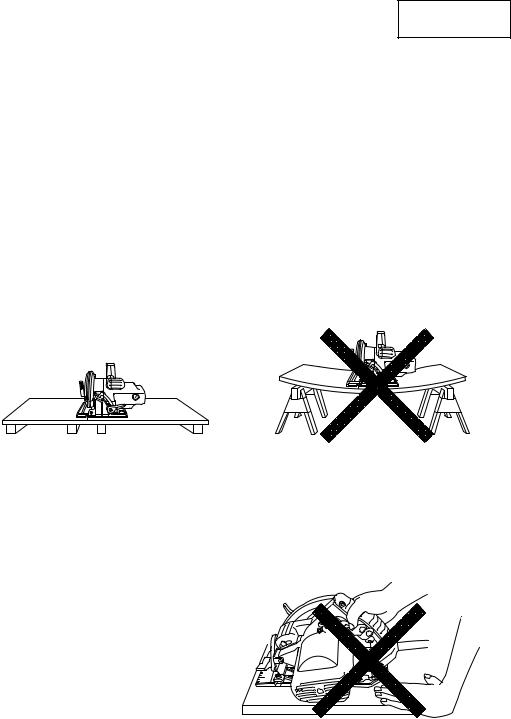
English
Kickback is the result of tool misuse and/or incorrect operating procedures or conditions and can be avoided by taking proper precautions as given below:
12.Maintain a firm grip with both hands on the saw and position your body and arm to allows you to resist KICKBACK forces. KICKBACK forces can be controlled by the operator, if proper precautions are taken.
13.When blade is binding, or when interrupting a cut for any reason, release the trigger and hold the saw motionless in the material until the blade comes to a complete stop. Never attempt to remove the saw from the work or pull the saw backward while the blade is in motion or KICKBACK may occur. Investigate and take corrective actions to eliminate the cause of blade binding.
14.When restarting a saw in the workpiece, center the saw blade in the kerf and check that saw teeth are not engaged into the material. If saw blade is binding, it may walk up or KICKBACK from the workpiece as the saw is restarted.
15.Support large panels to minimize the risk of blade pinching and KICKBACK. Large panels tend to sag under their own weight. Supports must be placed under the panel on both sides, near the line of cut and near the edge of the panel as shown in Fig. 1.
To minimize the risk of blade pinching and kickback. When cutting operation requires the resting of the saw on the work piece, the saw shall be rested on the larger portion and the smaller piece cut off.
To avoid kickback, do support board or panel near the cut.
Fig. 1
Don't support board or panel away from the cut.
Fig. 2
16.Do not use dull or damaged blade. Unsharpened or improperly set blades produce narrow kerf causing excessive friction, blade binding and KICKBACK.
17.Blade depth and bevel adjusting locking levers must be tight and secure before making cut. If blade adjustment shifts while cutting, it may cause binding and KICKBACK.
18.Use extra caution when making a “Pocket
Cut” into existing walls or other blind areas.
The protruding blade may cut objects that can cause KICKBACK.
NEVER place your hand or fingers behind the saw. If kickback occurs, the saw could easily jump backwards over your hand, possibly causing severe injury.
19. Be careful of brake kickback. (C7BD2 only)
Model C7BD2 features an electric brake that |
|
functions when the switch is released. As |
|
there is some kickback when the brake |
|
functions, be sure to hold the main body |
Fig. 3 |
securely. |
|
7
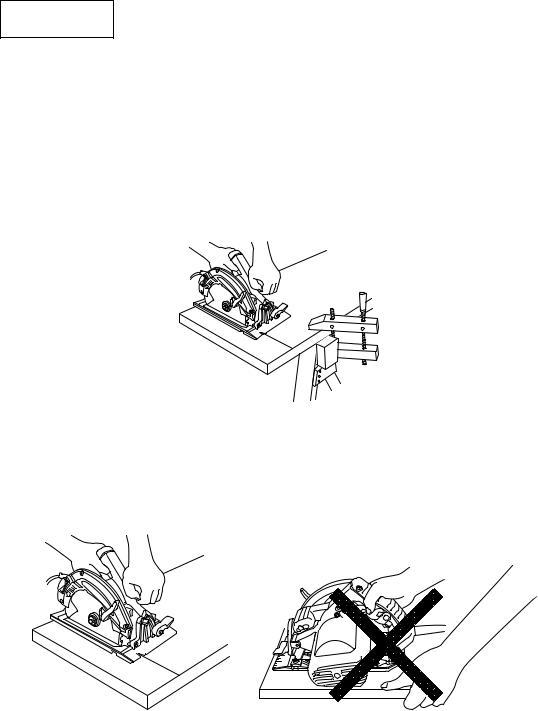
English
20.Adjustments. Before cutting be sure depth and bevel adjustments are tight.
21.Avoid cutting nails. Inspect for and remove all nails from work piece before cutting.
22.When operating the saw, keep the cord away from the cutting area and position it so that it will not be caught on the workpiece during the cutting operation.
Operate with proper hand support, proper workpiece support, and supply cord routing away from the work area.
WARNING: It is important to support the work piece properly and to hold the saw firmly to prevent loss of control which could cause personal injury. Fig. 4 illustrates typical hand support of the saw.
A TYPICAL ILLUSTRATION OF PROPER HAND SUPPORT
WORKPIECE SUPPORT, AND SUPPLY CORD ROUTING.
Fig. 4
23.Place the wider portion of the saw base on that part of the work piece which is solidly supported, not on the section that will fall off when the cut is made. As examples, Fig. 5 illustrates the RIGHT way to cut off the end of board, and Fig. 6 the WRONG way. If the work piece is short or small, clamp it down.
DON’T TRY TO HOLD SHORT PLACES BY HAND!
Fig. 5 |
Fig. 6 |
8
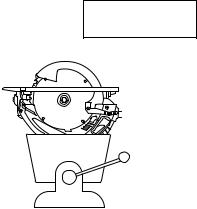
English
24. Never attempt to saw with the circular saw held upside down in a vise. This is extremely dangerous and can lead to serious accidents. (Fig. 7)
Fig. 7
25.Before setting the tool down after completing a cut, be sure that the lower (telescoping) guard has closed and the blade has come to a complete stop.
26.Never touch moving parts.
Never place your hands, fingers or other body parts near the tool’s moving parts.
27.Never operate without all guards in place.
Never operate this tool without all guards or safety features in place and in proper working order. If maintenance or servicing requires the removal of a guard or safety feature, be sure to replace the guard or safety feature before resuming operation of the tool.
28.Use right tool.
Don’t force small tool or attachment to do the job of a heavy-duty tool.
Don’t use tool for purpose not intended —for example— don’t use circular saw for cutting tree limbs or logs.
29.Never use a power tool for applications other than those specified.
Never use a power tool for applications other than those specified in the Instruction Manual.
30.Handle tool correctly.
Operate the tool according to the instructions provided herein. Do not drop or throw the tool. Never allow the tool to be operated by children, individuals unfamiliar with its operation or unauthorized personnel.
31.Keep motor air vent clean.
The tool’s motor air vent must be kept clean so that air can freely flow at all times. Check for dust build-up frequently.
32.Operate power tools at the rated voltage.
Operate the power tool at voltages specified on their nameplates.
If using the power tool at a higher voltage than the rated voltage, it will result in abnormally fast motor revolution and may damage the unit and burn out the motor.
33.Do not run the saw while carrying it at your side.
34.Keep all screws, bolts and covers tightly in place.
Keep all screws, bolts, and plates tightly mounted. Check their condition periodically.
35.Do not use power tools if the plastic housing or handle is cracked.
Cracks in the tool’s housing or handle can lead to electric shock. Such tools should not be used until repaired.
9

English
36.Blades and accessories must be securely mounted to the tool.
Prevent potential injuries to youself or others. Blades, cutting implements and accessories which have been mounted to the tool should be secure and tight.
37.Never use a tool which is defective or operating abnormally.
If the tool appears to be operating unusually, making strange noises, or otherwise appears defective, stop using it immediately and arrange for repairs by a Hitachi authorized service center.
38.Carefully handle power tools.
Should a power tool be dropped or struck against hard materials inadvertently, it may be deformed, cracked, or damaged.
39.Do not wipe plastic parts with solvent.
Solvents such as gasoline, thinner benzine, carbon tetrachloride, and alcohol may damage and crack plastic parts. Do not wipe them with such solvents.
Wipe plastic parts with a soft cloth lightly dampened with soapy water and dried thoroughly.
40.Never wear gloves made of material liable to roll up such as cotton, wool, cloth or string, etc.
41.Definitions for symbols
V ............ volts Hz .......... hertz
A ............ amperes
no .......... no load speed
 .......... Class II Construction
.......... Class II Construction
---/min ... revolutions per minute
 .......... alternating or direct current
.......... alternating or direct current
10

English
DOUBLE INSULATION FOR SAFER OPERATION
To ensure safer operation of this power tool, HITACHI has adopted a double insulation design. “Double insulation “ means that two physically separated insulation systems have been used to insulate the electrically conductive materials connected to the power supply from the outer frame handled by the operator. Therefore, either the symbol “ ” or the words “Double insulation” appear on the power tool or on the nameplate.
” or the words “Double insulation” appear on the power tool or on the nameplate.
Although this system has no external grounding, you must still follow the normal electrical safety precautions given in this Instruction Manual, including not using the power tool in wet environments.
To keep the double insulation system effective, follow these precautions:
Only HITACHI AUTHORIZED SERVICE CENTER should disassemble or assemble this power tool, and only genuine HITACHI replacement parts should be installed.
Clean the exterior of the power tool only with a soft cloth moistened with soapy water, and dry thoroughly.
Never use solvents, gasoline or thinners on plastic components; otherwise the plastic may dissolve.
SAVE THESE INSTRUCTIONS
AND
MAKE THEM AVAILABLE TO
OTHER USERS
AND
OWNERS OF THIS TOOL!
11
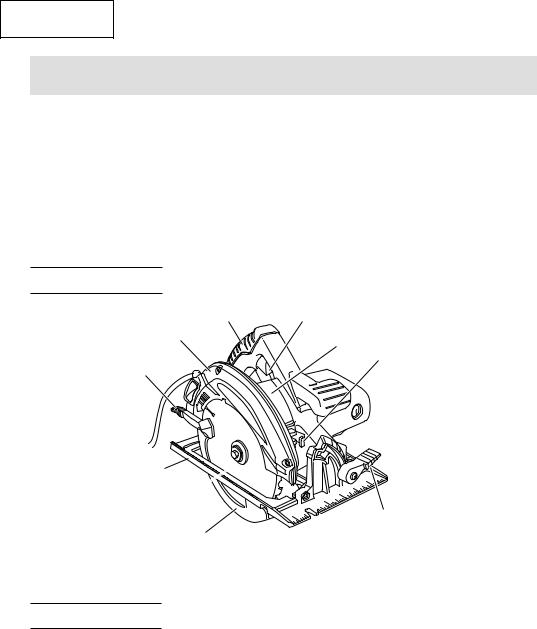
English
FUNCTIONAL DESCRIPTION
NOTE:
The information contained in this Instruction Manual is designed to assist you in the safe operation and maintenance of the power tool.
NEVER operate, or attempt any maintenance on the tool unless you have first read and understood all safety instructions contained in this manual.
Some illustrations in this Instruction Manual may show details or attachments that differ from those on your own power tool.
NAME OF PARTS
Handle |
Switch |
Blade Cover |
Gear Cover |
|
|
Lever |
Lock Lever |
(Retracting |
|
Handle) |
|
Base
Saw Blade
Lever (A)
Lower Guard
Fig. 8
SPECIFICATIONS
Motor |
Single-Phase, Series Commutator Motor |
Power Source |
Single-Phase 120V AC 60Hz, 120V DC |
Max. Cutting Depth |
2-3/8" (60mm) |
Current |
15 A |
No-Load Speed |
5800/min. |
Weight (without cord) |
10.1 lbs (4.6 kg) |
|
|
12
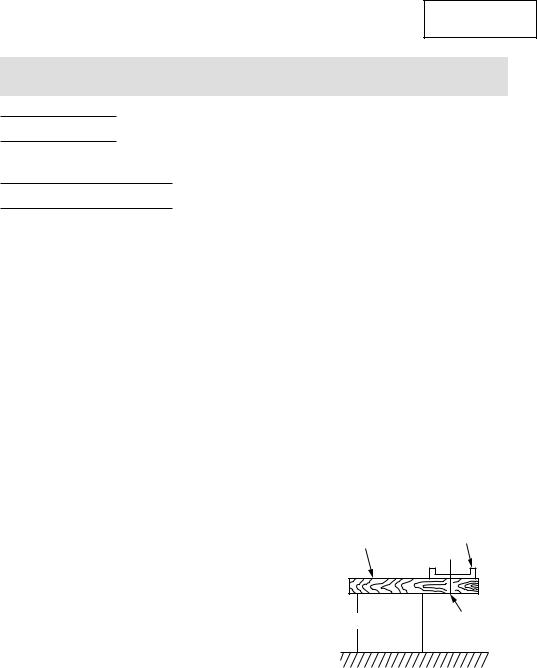
English
ASSEMBLY AND OPERATION
APPLICATIONS
Cutting Various types of wood.
PRIOR TO OPERATION
1.Power source
Ensure that the power source to be utilized conforms to the power source requirements specified on the product nameplate.
2.Power switch
Ensure that the switch is in the OFF position. If the plug is connected to a receptacle while the switch is in the ON position, the power tool will start operating immediately and can cause serious injury.
3.Extension cord
When the work area is far away from the power source, use an extension cord of sufficient thickness and rated capacity. The extension cord should be kept as short as practicable.
 WARNING: Damaged cord must be replaced or repaired.
WARNING: Damaged cord must be replaced or repaired.
4.Check the receptacle
If the receptacle only loosely accepts the plug, the receptacle must be repaired. Contact a licensed electrician to make appropriate repairs.
If such a faulty receptacle is used, it may cause overheating, resulting in a serious hazard.
5.Confirming condition of the environment:
Confirm that the work site is placed under appropriate conditions conforming to prescribed precautions.
6.Prepare a wooden workbench (Fig. 9)
Since the saw blade will extend beyond the lower surface of the work piece, place the work piece on a workbench when cutting. If a square block is utilized as a workbench, select level ground to ensure it is properly stabilized. An unstable workbench will result in hazardous operation.
 CAUTION:
CAUTION:
To avoid possible accident, always ensure that the portion of work piece remaining after cutting is securely anchored or held in position.
Work piece |
Base |
Workbench |
Saw Blade |
Fig. 9
13

English
7.Check if lever (A)s are tightened.
If the lever (A) to adjust cutting depth (Fig. 10) and lever (A) to adjust angle of inclination (Fig. 11) are loose, injury can result. Make sure that they are tightened securely.
8.Check performance of safety cover
 WARNING: Make absolutely sure that the safety cover is not fixed. Also, check and see if it can move smoothly. If the saw blade is kept exposed injury can result.
WARNING: Make absolutely sure that the safety cover is not fixed. Also, check and see if it can move smoothly. If the saw blade is kept exposed injury can result.
The lower guard (refer to Fig. 8) serves to protect your body from coming into contact with the saw blade. Make absolutely certain that the cover smoothly performs to cover the saw blade. If the safety cover should not move smoothly, never use it without repairing it.
In such a case, get in touch with the store where you bought the circular saw or the HITACHI Authorized Service Center for necessary repair.
9.Eye protection
When you use the tool, make certain that you wear eye protection.
10.Check if saw blade is tightened
Refer to [mounting and dismounting the saw blade] in Page 17, and make sure that the flange bolt is tightened securely.
11.Check for proper operation of the brake (C7BD2 only).
Your saw has an automatic electric brake which is designed to stop the blade from coasting in about 3 seconds, after you release the trigger switch. It is useful when making certain cuts in wood where a coasting blade would result a wide imprecise cut. Occasionally, under certain conditions, the brake will not function properly and won't stop the saw in the 3 seconds discussed above.
If this condition persists, turn the saw on and off four or five times. If the brake still does not stop the blade in about 3 seconds, the problem may be worn brushes. Replace the brushes and try the saw again. If the problem still persists, have the tool serviced at a HITACHI AUTHRIZED SERVICE CENTER.
ADJUSTSING THE SAW PRIOR TO USE
 WARNING:
WARNING:
To avoid serious accidents, ensure the switch is in OFF position, and disconnect the plug from the receptacle.
Loosen
Tighten
Lever (A)
Link
Base
Fig. 10
14

English
1. Adjusting the cutting depth (Fig. 10)
 WARNING:
WARNING:
If the lever (A) is loose, injury can result. Tighten it securely after adjustment.
To adjust cutting depth, loosen the lever (A) and, while holding the base with one hand, move the main body up and down to obtain the prescribed cutting depth. After adjusting to the prescribed cutting depth, tighten the lever
(A) securely.
2.Adjusting the angle of inclination
 WARNING:
WARNING:
If the lever (A) is loose, injury can result. Tighten it securely after adjustment.
You can incline saw blade from 0˚ to a maximun angle of 55˚ in relation to the base.
As shown in Fig. 11 by loosing the lever (A) on the bevel scale, the saw blade may be inclined to an angle of 45˚ in relation to the base.
If you use inclination angle of over 45˚, as shown in Fig. 12 move the lever (A) to inside, the saw blade may be inclined to a maximum angle of 55˚ in relation to the base.
Always ensure that the lever (A) is thoroughly tightened after making the desired adjustment.
3. Regulating the guide (Rip fence) (Fig. 13,
14)
........................................ Optional Accessory
Install the wing bolt (B) and lock spring on the base. Insert the guide into the base, move it left and right and adjust the cutting position. Tighten the wing bolt (B) and fix the guide. The guide can be installed either from the left or the right side of the main body.
Lever (A)
0˚ – 45˚
Fig. 11
45˚ – 55˚
55˚
Fig. 12
Wing
Bolt (B)
Lock
Spring 

Base
Fig. 13
Wing Bolt (B), Lock Spring
Base
Guide
(Rip Fence)
Fig. 14
15
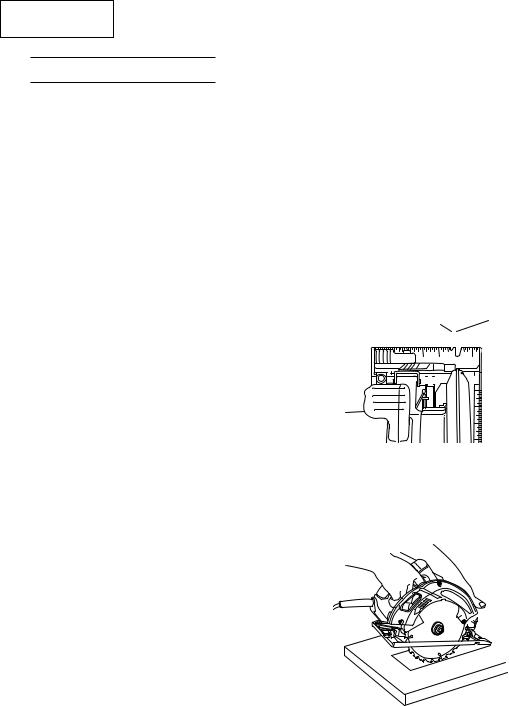
English
CUTTING PROCEDURES
 WARNING:
WARNING:
●Never touch the moving parts.
●Should the saw blade be stopped or make an abnormol noise during operation, turn off the switch immediately.
●Don't remove circular saw from work piece during a cut while the saw blade is moving.
●Wear eye protection.
●Avoid cutting any material like metal, etc., that give off sparks.
 CAUTION:
CAUTION:
●Always take care in preventing the power cord from coming near the revolving saw blade.
●Before starting to saw, ensure that the saw blade has reached full speed revolution.
1.Place the saw body (base) on the work piece, and as in Fig. 15 align the intended line of cut with the saw blade, using the notch at the front of the base. This relationship of base to work pieces should remain unchanged regardless of the inclination of the base.
2.The switch should be turned to the ON position before the saw blade comes into contact with the work piece. The switch is turned ON when the trigger is pulled by one’s finger, and is turned OFF when the trigger is released.
3.Moving the saw straight at a constant speed will produce optimum cutting.
[POCKET CUTTING]
When |
|
When |
||||||
Inclined |
|
|
|
|||||
|
|
|
not |
|||||
45° |
|
|
|
|
|
|
||
|
|
|
|
|
|
Inclined |
||
|
|
|
|
|
|
|
|
|
|
|
|
|
|
|
|
|
|
|
|
|
|
|
|
|
|
|
|
|
|
|
|
|
|
|
|
Fig. 15
 WARNING:
WARNING:
●To avoid serious accident, ensure the switch is OFF position, and disconnect the plug from the receptacle before any adjustment.
●Never tie or wedge the lower guard in a raised position.
1.Mark the desired cutting area clearly with lines all side. (See Fig. 16)
2.Set depth adjustment according to material to be cut.
3.Push the lever all the way back so the blade is exposed as shown in Fig. 16.
4.Tilt saw forward and align the notch (Fig. 15) with the pre-marked guide line.
 Lever
Lever
Fig. 16
16
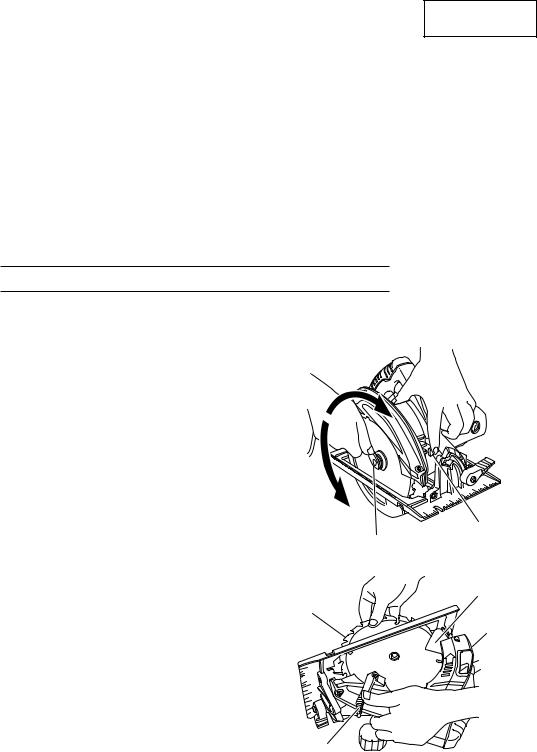
English
5.Release the lever. When the lower guard contacts the work piece surface, it will be in proper position to open freely when cutting is commencend.
6.Holding the saw in position, with the blade not contacting the work piece surface, pull the trigger.
7.After the saw has reached full speed, gradually lower rear end of the saw until its base rests on the work surface.
8.Advance saw along the cutting line up to the corner.
9.Release trigger and allow blade to stop completely before withdrawing the blade from the work piece.
Never under any circumstances pull the saw backwards while the blade is in motion, as kickback may result.
10.Use a jig saw or hand saw to cut the corners out clean.
11.When starting each new cut, repeat as above.
MOUNTING AND DISMOUNTING THE SAW BLADE
 WARNING: To avoid serious accident ensure the switch is in the OFF position, and disconnect the plug from the receptacle.
WARNING: To avoid serious accident ensure the switch is in the OFF position, and disconnect the plug from the receptacle.
1.Dismounting the saw blade
(1)Set the cutting volume at maximum, and place the Circular Saw as shown in Fig. 17.
(2)Depress the lock lever, lock the spindle, and remove the hexagonal-flange bolt and washer(B) with the wrench.
(3)While holding the lever to keep the lower guard fully retracted into the blade cover, remove the saw blade. (Fig. 18)
2.Mounting the saw blade
(1)Thoroughly remove any sawdust which has accumulated on the spindle, bolt and washers.
(2)For mounting saw blade, the concave sides of both washers (A) and (B) must be fitted to the saw blade sides. Mount the saw blade on the spindle, and finally affix washer (B) (See Fig. 19)
(3)To assure proper rotation direction of the saw blade, the arrow direction on the saw blade must coincide with the arrow direction on the blade cover.
Tighten
Loosen
Lock Lever
Wrench
Fig. 17
|
Lower Guard |
Saw Blade |
Blade |
|
|
|
Cover |
Lever
Fig. 18
17
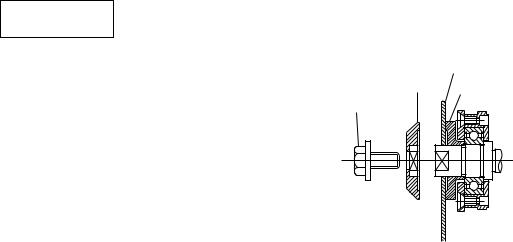
English
(4)Using the fingers, tighten the hexagonal bolt retaining the saw blade as much as possible. Then depress the lock lever, lock the spindle, and thoroughly tighten the bolt.
(5)Confirm that the lock lever is in the original position.
Saw Blade
Washer (B)
Hexagonal Washer (A)
Flange Bolt
Fig. 19
18
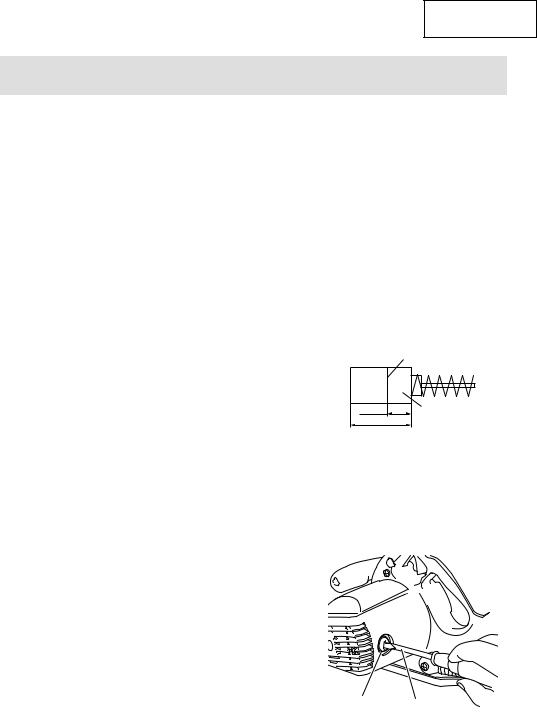
English
MAINTENANCE AND INSPECTION
 WARNING: To avoid serious accident, ensure the switch is in the OFF position and disconnect the plug from the receptacle during maintenance and inspection.
WARNING: To avoid serious accident, ensure the switch is in the OFF position and disconnect the plug from the receptacle during maintenance and inspection.
1.Inspecting the saw blade:
Since use of a dull saw blade will degrade efficiency and cause possible motor malfunction, sharpen or replace the saw blade as soon as abrasion is noted.
 CAUTION:
CAUTION:
If a dull saw blade is used, reactive force is increased during cutting operation. Avoid the use of the dull saw blade without repair.
2.Check the screws
Loose screws are dangerous. Regularly inspect them and make sure they are tight.
 CAUTION: Using this power tool with loosened screws is extremely dangerous.
CAUTION: Using this power tool with loosened screws is extremely dangerous.
3.Inspecting the carbon brushes (Fig. 20)
The motor employs carbon brushes which are consumable parts. Replace the carbon brush with a new one when it becomes worn to its wear limit. Always keep carbon brushes clean and ensure that they slide freely within the brush holders.
|
|
Wear limit |
|
|
|
38 |
|
(6mm) |
0.24" |
No. of carbon |
|
0.67" |
|
|
|
|
|
brush |
|
(17mm) |
|
||
 CAUTION:
CAUTION:
Using this circular saw with a carbon brush which is worn in excess of the wear limit will damge the motor.
NOTE: Use HITACHI carbon brush No. 38 indicated in Fig. 20.
4. Replacing carbon brushes:
Remove the brush caps with a slotted-head screwdriver. The carbon brushes can then be easily removed. (Fig. 21)
5. Performance checkup and maintenance of
safety cover |
|
Keep the safety cover in good shape for smooth |
|
performance at all times. Be sure to make |
|
prompt repair in case of any malfunction. |
|
6. Adjusting the base and saw blade to |
|
maintain perpendicularity |
|
The angle between the base and the saw blade |
Brush Cap Slotted-head |
has been adjusted to 90°, however should this |
Screwdriver |
|
|
|
Fig. 21 |
19
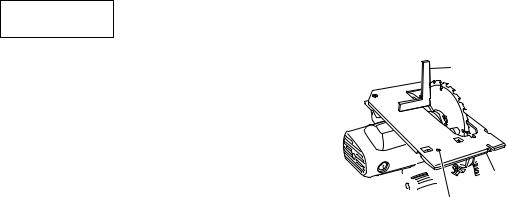
English
perpendicularity be lost for some reason, adjust in the following manner.
(1)Turn the base face up (Fig. 22) and loosen the lever (A).
(2)Apply a square to the base and the saw blade and, turning the slotted set screw with a slottedhead screwdriver, shift the position of the base to produce the desired right angle.
7. Service parts list
Square

 Base
Base
Slotted Set Screw
Fig. 22
 CAUTION:
CAUTION:
Repair, modification and inspection of Hitachi Power Tools must be carried out by an Hitachi Authorized Service Center.
This Parts List will be helpful if presented with the tool to the Hitachi Authorized Service Center when requesting repair or other maintenance. In the operation and maintenance of power tools, the safety regulations and standards prescribed in each country must be observed.
MODIFICATIONS:
Hitachi Power Tools are constantly being improved and modified to incorporate the latest technological advancements.
Accordingly, some parts (i.e. code numbers and/or design) may be changed without prior notice.
20
